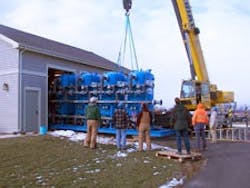Water Treatment Plant Supports Major Illinois Community Development
| Related Searches from WaterInfoLink.com Arsenic Removal | Iron and Manganese Removal | Layne Christensen | Maximum Contaminant Level |
As community developers know, a stable, quality water supply is essential to any development plan. So when Lakewood Homes planned to develop the 2,200-lot community of Lakewood Springs, Ill., they turned to Layne Christensen Co. Lakewood Homes began by purchasing a pre-existing well from the City of Yorkville, Ill. The well had been drilled by the nation’s largest municipal well driller, Layne Christensen , in 1998, but this well alone was unable to provide the necessary water supply for so large a development.
Historically, filtration methods for iron and manganese have been designed around 3-gpm/sq ft flow rates and require the addition of both potassium permanganate and chlorine to oxidize and remove the contaminants. Layne proposed a more efficient design that accommodates a 10-gpm/sq ft loading rate, and requires only one oxidant, sodium hypochlorite. Layne’s design was less expensive to construct, and the improved performance also provides financial benefits in the form of a smaller building, reduce chemical use and lower operating costs.
Lakewood Homes awarded Layne a contract to furnish catalytic iron and manganese removal equipment. The custom-engineered systems use LayneOx , a highly efficient granular catalytic filter media with naturally high manganese dioxide content. The LayneOx process can be used to remove iron, manganese, hydrogen sulfide and even arsenic , all in one backwashable process.
Since this was the first plant of its kind in Illinois, and the LayneOx catalytic treatment method was new in Illinois, the state EPA required a six-week pilot test to demonstrate the process. In partnership with Odell Engineering of Sugar Grove, Ill., the pilot testing was completed successfully and the first two treatment trains were delivered. The third treatment system was installed following the installation of the third well, bringing the total treatment capacity to 1,600 gpm.
The 1,600-gpm LayneOx treatment equipment was designed to use self-produced water to backwash the system without using distribution water. This eliminated the need for backwash storage tanks and the pumps needed with other designs.
